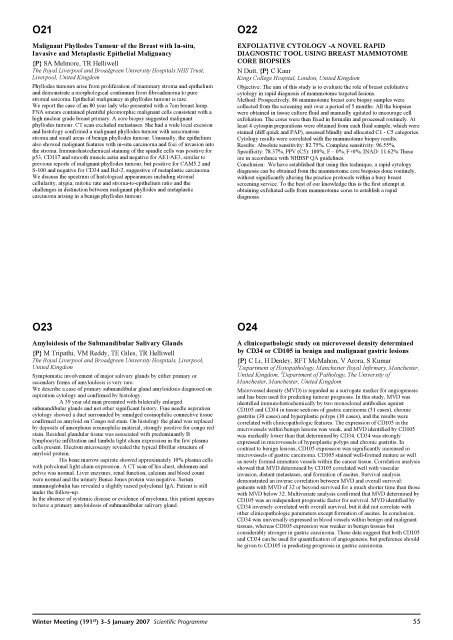2007 Winter Meeting - London - The Pathological Society of Great ...
2007 Winter Meeting - London - The Pathological Society of Great ...
2007 Winter Meeting - London - The Pathological Society of Great ...
- No tags were found...
Create successful ePaper yourself
Turn your PDF publications into a flip-book with our unique Google optimized e-Paper software.
O21Malignant Phyllodes Tumour <strong>of</strong> the Breast with In-situ,Invasive and Metaplastic Epithelial Malignancy{P} SA Melmore, TR Helliwell<strong>The</strong> Royal Liverpool and Broadgreen University Hospitals NHS Trust,Liverpool, United KingdomPhyllodes tumours arise from proliferation <strong>of</strong> mammary stroma and epitheliumand demonstrate a morphological continuum from fibroadenoma to purestromal sarcoma. Epithelial malignancy in phyllodes tumour is rare.We report the case <strong>of</strong> an 80 year lady who presented with a 7cm breast lump.FNA smears contained plentiful pleomorphic malignant cells consistent with ahigh nuclear grade breast primary. A core biopsy suggested malignantphyllodes tumour. CT scan excluded metastases. She had a wide local excisionand histology confirmed a malignant phyllodes tumour with sarcomatousstroma and small areas <strong>of</strong> benign phyllodes tumour. Unusually, the epitheliumalso showed malignant features with in-situ carcinoma and foci <strong>of</strong> invasion intothe stroma. Immunohistochemical staining <strong>of</strong> the spindle cells was positive forp53, CD117 and smooth muscle actin and negative for AE1/AE3, similar toprevious reports <strong>of</strong> malignant phyllodes tumour, but positive for CAM5.2 andS-100 and negative for CD34 and Bcl-2, suggestive <strong>of</strong> metaplastic carcinoma.We discuss the spectrum <strong>of</strong> histological appearances including stromalcellularity, atypia, mitotic rate and stroma-to-epithelium ratio and thechallenges in distinction between malignant phyllodes and metaplasticcarcinoma arising in a benign phyllodes tumour.O22EXFOLIATIVE CYTOLOGY -A NOVEL RAPIDDIAGNOSTIC TOOL USING BREAST MAMMOTOMECORE BIOPSIESN Dutt, {P} C KaurKings College Hospital, <strong>London</strong>, United KingdomObjective: <strong>The</strong> aim <strong>of</strong> this study is to evaluate the role <strong>of</strong> breast exfoliativecytology in rapid diagnosis <strong>of</strong> mammotome targeted lesions.Method: Prospectively, 86 mammotome breast core biopsy samples werecollected from the screening unit over a period <strong>of</strong> 5 months. All the biopsieswere obtained in tissue culture fluid and manually agitated to encourage cellexfoliation. <strong>The</strong> cores were then fixed in formalin and processed routinely. Atleast 4 cytospin preparations were obtained from each fluid sample, which werestained (diff quick and PAP), assessed blindly and allocated C1 - C5 categories.Cytology results were correlated with the mammotome biopsy results.Results: Absolute sensitivity: 82.75%, Complete sensitivity: 96.55%,Specificity: 78.37%, PPV (C5): 100%, F – 0%, F+0%, INAD: 11.62% <strong>The</strong>seare in accordance with NHBSP QA guidelines.Conclusion: We have established that using this technique, a rapid cytologydiagnosis can be obtained from the mammotome core biopsies done routinely,without significantly altering the practice protocols within a busy breastscreening service. To the best <strong>of</strong> our knowledge this is the first attempt atobtaining exfoliated cells from mammotome cores to establish a rapiddiagnosis.O23Amyloidosis <strong>of</strong> the Submandibular Salivary Glands{P} M Tripathi, VM Reddy, TE Giles, TR Helliwell<strong>The</strong> Royal Liverpool and Broadgreen University Hospitals, Liverpool,United KingdomSymptomatic involvement <strong>of</strong> major salivary glands by either primary orsecondary forms <strong>of</strong> amyloidosis is very rare.We describe a case <strong>of</strong> primary submandibular gland amyloidosis diagnosed onaspiration cytology and confirmed by histology.A 39 year old man presented with bilaterally enlargedsubmandibular glands and not other significant history. Fine needle aspirationcytology showed a duct surrounded by smudged eosinophilic connective tissueconfirmed as amyloid on Congo red stain. On histology the gland was replacedby deposits <strong>of</strong> amorphous eosinophilic material, strongly positive for congo redstain. Residual glandular tissue was associated with predominantly Blymphocytic infiltration and lambda light chain expression in the few plasmacells present. Electron microscopy revealed the typical fibrillar structure <strong>of</strong>amyloid protein.His bone marrow aspirate showed approximately 10% plasma cellswith polyclonal light chain expression. A CT scan <strong>of</strong> his chest, abdomen andpelvis was normal. Liver enzymes, renal function, calcium and blood countwere normal and the urinary Bence Jones protein was negative. Serumimmunoglobulin has revealed a slightly raised polyclonal IgA. Patient is stillunder the follow-up.In the absence <strong>of</strong> systemic disease or evidence <strong>of</strong> myeloma, this patient appearsto have a primary amyloidosis <strong>of</strong> submandibular salivary gland.O24A clinicopathologic study on microvessel density determinedby CD34 or CD105 in benign and malignant gastric lesions{P} C Li, H Denley, RFT McMahon, V Arora, S Kumar1 Department <strong>of</strong> Histopathology, Manchester Royal Infirmary, Manchester,United Kingdom, 2 Department <strong>of</strong> Pathology, <strong>The</strong> University <strong>of</strong>Manchester, Manchester, United KingdomMicrovessel density (MVD) is regarded as a surrogate marker for angiogenesisand has been used for predicting tumour prognosis. In this study, MVD wasidentified immunohistochemically by two monoclonal antibodies againstCD105 and CD34 in tissue sections <strong>of</strong> gastric carcinoma (51 cases), chronicgastritis (30 cases) and hyperplastic polyps (10 cases), and the results werecorrelated with clinicopathologic features. <strong>The</strong> expression <strong>of</strong> CD105 in themicrovessels within benign lesions was weak, and MVD identified by CD105was markedly lower than that determined by CD34. CD34 was stronglyexpressed in microvessels <strong>of</strong> hyperplastic polyps and chronic gastritis. Incontrast to benign lesions, CD105 expression was significantly increased inmicrovessels <strong>of</strong> gastric carcinoma. CD105 stained well-formed mature as wellas newly formed immature vessels within the cancer tissue. Correlation analysisshowed that MVD determined by CD105 correlated well with vascularinvasion, distant metastases, and formation <strong>of</strong> ascites. Survival analysisdemonstrated an inverse correlation between MVD and overall survival:patients with MVD <strong>of</strong> 32 or beyond survived for a much shorter time than thosewith MVD below 32. Multivariate analysis confirmed that MVD determined byCD105 was an independent prognostic factor for survival. MVD identified byCD34 inversely correlated with overall survival, but it did not correlate withother clinicopathologic parameters except formation <strong>of</strong> ascites. In conclusion,CD34 was universally expressed in blood vessels within benign and malignanttissues, whereas CD105 expression was weaker in benign tissues butconsiderably stronger in gastric carcinoma. <strong>The</strong>se data suggest that both CD105and CD34 can be used for quantification <strong>of</strong> angiogenesis, but preference shouldbe given to CD105 in predicting prognosis in gastric carcinoma.<strong>Winter</strong> <strong>Meeting</strong> (191 st ) 3–5 January <strong>2007</strong> Scientific Programme55













